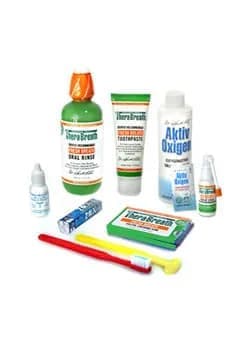A comprehensive halitosis definition not only involves its well-known meaning but also the reasons why it occurs and what can be done about it. Halitosis is simply bad breath, or more specifically, chronic bad breath that persists even when the individual afflicted with halitosis takes steps to reduce it. The word is a combination of the Latin halitus and the Greek suffix -osis, and literally means "breath condition".
Acknowledgment of bad breath is documented from Egyptian medical writings dating back to 1500 BCE. Ancient physicians suggested using a combination of herbs and wine to eliminate halitosis. Early Chinese holistic healers understood that the white coating on the tongue may be responsible for bad breath and invented a rudimentary tongue cleaner. However, it wasn't until the 1920s when Listerine began an aggressive marketing campaign for its mouthwash that the term "halitosis" became part of everyday vocabulary.
Nearly 50 years ago, Dr. J. Tonzetich, a researcher working for the University of British Columbia, finally discovered the root cause of bad breath by showing that anaerobic bacteria and the volatile sulfur compounds they excrete as waste material causes halitosis. Building on this revelation, scientists were then able to create solutions that target and eliminate this type of bacteria.
What Causes Halitosis
The primary cause of halitosis is dry mouth, or xerostomia. In addition to helping us chew, swallow and digest food, saliva also promotes oral health and maintains an optimal pH level in the mouth (above seven percent). When someone suffers from xerostomia, the mouth becomes a terrific breeding ground for anaerobic bacteria, or bacteria that thrive in environments where little to no oxygen exists. In addition, pH levels decrease creating a high acidic condition also conducive to growth of anaerobic bacteria.
When discussing a halitosis, it is necessary to understand why these bacteria cause bad breath. These oral anaerobes consume proteins in the form of mucus, food particles and other mouth debris that is not adequately brushed and rinsed away. A mouth that experiences dry mouth does not have enough oxygenating saliva to help eliminate mouth debris.
As a result, the bacteria that consume oral proteins emit substantial amounts of sulfurous compounds that smell like rotten eggs or decaying organic matter. So what essentially causes chronic halitosis is the excrement of anaerobic bacteria facilitated by the fermentation of peptides and proteins found in gingival crevicular fluid, saliva, desquamated epithelial cells and blood.
Volatile sulfur compounds produce the most malodorous substances delineating a halitosis definition. VSCs primarily contain dimethyl sulfide, hydrogen sulfide and methyl mercaptan, all compounds that emit strong, foul odors resembling rotten eggs and/or decaying flesh. Gram-negative anaerobic bacteria found in plaque also create bad breath by filling the mouth with powerfully smelling metabolic by-products such as putrescine, valeric acid, skatole and butyric acid.
Bacterial species prevalent in cases of chronic halitosis include: Eubacterium, Porphyromonas gingivalis, Treponema denticola, and Tannerella forsythensis. These kinds of bacteria also cause tooth decay and other serious oral diseases that could potentially produce sepsis, a dangerous infection of the blood due to untreated infection.
Halitosis is sometimes caused by tonsilloliths, or tonsil stones embedded in the tonsils. Tonsil stones are small, white specks of calcified mouth debris that emit sulfurous odors when bitten or when they naturally disintegrate.
Eliminating Halitosis
 To successfully eliminate halitosis is to eliminate a dry mouth condition and/or begin correcting mouth and gum issues. However, if someone suffering from bad breath has no dental problems or gum disease, then increasing saliva levels and destroying the anaerobic bacteria that has been allowed to proliferate in a dry mouth is imperative. Using special mouthwashes and toothpastes containing ingredients aimed at raising oral oxygen levels will aggressively attack the problem and begin reducing bad breath immediately.
To successfully eliminate halitosis is to eliminate a dry mouth condition and/or begin correcting mouth and gum issues. However, if someone suffering from bad breath has no dental problems or gum disease, then increasing saliva levels and destroying the anaerobic bacteria that has been allowed to proliferate in a dry mouth is imperative. Using special mouthwashes and toothpastes containing ingredients aimed at raising oral oxygen levels will aggressively attack the problem and begin reducing bad breath immediately.
While a simple halitosis definition implies that someone has bad breath, the term involves much more than masking the odor with ineffective mouthwashes and chewing gums. Sulfurous anaerobic bacteria are the culprits behind bad breath and eradicating them with the ingredient OXYD-8 found in TheraBreath products will result in breath that is fresh, clean and free of bacterial waste.
